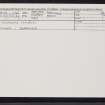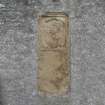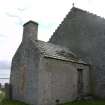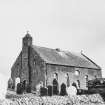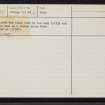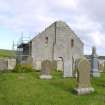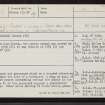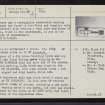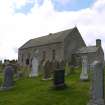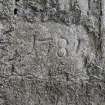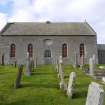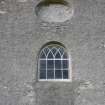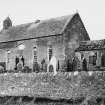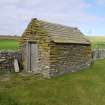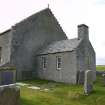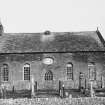Following the launch of trove.scot in February 2025 we are now planning the retiral of some of our webservices. Canmore will be switched off on 24th June 2025. Information about the closure can be found on the HES website: Retiral of HES web services | Historic Environment Scotland
Holm, St Nicholas' Church
Church (18th Century), Settlement (Period Unassigned)
Site Name Holm, St Nicholas' Church
Classification Church (18th Century), Settlement (Period Unassigned)
Alternative Name(s) Holm Kirk
Canmore ID 3045
Site Number HY50SW 14
NGR HY 51042 00638
Datum OSGB36 - NGR
Permalink http://canmore.org.uk/site/3045
- Council Orkney Islands
- Parish Holm
- Former Region Orkney Islands Area
- Former District Orkney
- Former County Orkney
St Nicholas’ Church, Holm, Orkney, recumbent cross-slab
Measurements: L 1.42m, W 0.44m tapering to 0.33m at the foot
Stone type: sandstone
Place of discovery: HY 5104 0063
Present location: St Margaret’s Chapel, Graemeshall, Holm.
Evidence for discovery: found in the floor of St Nicholas’ Church during repair work in 1893, and subsequently taken to the new private chapel at Graemeshall.
Present condition: very worn.
Description
The slab has been shaped and carved on one broad face in low relief with a flatband moulding along the edges and an almost central cross. The latter consists of an equal-armed cross-head on a narrow shaft on a square base. The cross is outlined with roll moulding, and the side-arms overlap the edge moulding (there is no bar between the shaft and the base as shown in ECMS). The centre of the cross-head is square, thus forming stepped and closed armpits. It is clear that the cross was entirely filled with various forms of interlace, but the carving inside the upper, left-hand and lower arms, as well as the central panel, is very worn and difficult to make out. The ornament in the right-hand arm consists of a circle interlaced by a four-loop cord, the shaft is filled with triangular interlace enclosing central lozenges and the base with symmetrical triquetra knots in a cruciform pattern.
Date: tenth century.
References: ECMS pt 3, 21-3; RCAHMS 1946, no 359, fig 152; Fisher 2002, 45-7; Scott & Ritchie 2014, no 25.
Compiled by A Ritchie 2017
HY50SW 14 51042 00638
(HY 5104 0064) Church (NR)
OS 6" map, Orkney, 2nd ed.,(1903).
St. Nicholas Church, the parish church was served by a reader in 1570 (H Scott 1928): It was rebuilt in 1781 (Statistical Account [OSA, J Alison] 1793) and again in 1818 (New Statistical Account [NSA, A Smith] 1845).
(Undated) information in NMRS.
The church and graveyard stand on a rounded elevation which resembles the site of a broch,and a ring or wall of a circular stonework protruding through the summit in the field to the N. of the graveyard suggest a prehistoric construction. Other stone walling is found during grave- digging. Many years ago a rectangular cross-slab bearing Celtic ornament was found in the floor and together with a small sepulchral slab bearing a very rare sculpture of three swords, found in the churchyard, is now in the private chapel at Graemeshall.(Proc Soc Antiq Scot 1901 Donations).
J R Allen and J Anderson 1903; RCAHMS 1946, visited 5 July 1935.
There is no evidence of a broch. The ring of stones, recorded above is at HY 5101 0065.
The corner of a dry stone building (with walling 1.0m thick) was found during grave digging by Mr Louttit of Woodstock, Holm, Orkney at HY 5105 0064 near the east end of the church. More dry stone walling, 0.8m thick was found in the same way at HY 5101 0064, with many animal bones , and some barrel shaped red clay beads, since lost.
A third dry-stone wall was found about 5 years ago by Mr A Tait of Nether Bow, Holm at HY 5101 0066. In this area he removed about 40 trailer loads of stones, including a red sand- stone block bearing about 6 cup marks, and many sea shells. These he dumped on the shore at HY 5088 0075, but there is now no trace of the cup-marked stone. The
church was taken over by the Army in 1939 and has not been used as a church since then.
Surveyed at 1/2500.
Visited by OS (NKB) 28 August 1964.
Church visible on air photograph (OS 63/45/140, flown 1963).
(Undated) information in NMRS.
In 1893 'The Orkney Herald' reported that a cross found here was to be mounted.
The Orkney Herald 189
Mr Martin Howe has visited the are and sent the follwoing report:
The area has been deeply ploughed recently and archaeological remains are scattered across an area of the order
of thirty metres across. Amongst the structural remains are stones about a 1m acoss and one about a cubic foot, which gives some measure of the disturbance.
There are also other materials - burnt and unburnt pottery sherds with fragments (some of the red point may be unburnt), stone tools and iron slag. One piece of stone examined seemed too crooked in appearance, but it fell very
naturally into the hand and even had a curve that perfectly fitted the fleshy mount at the base of my thumb. Towards the base of the hill were many smaller fragments such as you might expect from a burnt mound, but even
there I found two pieces of curved heavy red stone with bright inclusions that were roughly three and four inches across and looked like fragments of some larger original. The site really needs a professional eye run over it, before matters deteriorate much further, in order to reach a properly informed assessment.
It is possible that some of the unearthed material relates to the mediaeval chapel at St.Nicholas Church in Holm, and a -mohr placename in the area indicates the dedication may come from even earlier, though not having
seen it I would hesitate to assign the now destroyed ring of stones outwith the kirkyard wall to a lleyn precinct.
Of course now that the site has been this heavily ploughed it is expected that the farmer may shortly remove all of the larger stones, along with anything dense enough to trouble the plough in future (such as slag). The pottery fragments that I could see were on the order of a centimetre thick, the unburnt pot I recognised from my time at The Howe in Stromness - it is slightly coarse, and mid earth brown with a dark-brown/black outer
surface.
Right at the top of the hillock, exposed on the topsoil by the border a bone. Some kind of joint (elbow or animal equivalent), bumps where the tendons would go
Information to RCAHMS via e-mail from M Howe, 21 April 2006
The farmer has ploughed the field for a second time and this has produced a second area of potshreds, different to that found previously.
The sherds come from two areas (in the region of HY 5098 0065). They have very thick bases, with walls about 1/2cm thick. The composition would appear to be of very fine clay.
Information to RCAHMS via e-mail from M Howe, 29 April 2006
Rebuilt, 1781, renovated (or rebuilt again)1818. 5-bay, symmetrical, rectangular-plan, crowstepped gabled, plain hall church with low 2-bay rectangular-plan vestry to E end. Harled. Walled churchyard extending around church with outbuilding to northern wall. Small-pane timber-framed window with simple intersecting tracery to S; other church windows blocked; 12-pane timber sash and case windows to vestry. Caithness stone tiled roof; central square-plan timber vent; old Orkney grey slate to vestry; corniced harled stack to vestry gable.
Records in the Kirkwall Archives note how the reverend James Grahame was minister of St Nicholas, Church, Holm, from 1688-1721; the Old Statistical Account records that the church was rebuilt in 1781; it was subsequently rebuilt in 1816. Photographs taken in 1975 show the existence of a simple, ball-finialled, pyramidal capped bellcote to the W gable. (Historic Scotland)
Field Visit (6 August 1929)
(1) In the private chapel of the mansion-house at Graemeshall, built against the N. wall near the altar, is a rectangular cross-slab of sandstone (ECM, iii, 21-2), found many years ago in the floor of the parish church at Holm and removed to its present position for better preservation. Sculptured in relief on one face only, it is 4 ft. 9 in. in length, while its width is 15 in. at the ends and 1 ft. 4 ½ in. in the middle. Around the edge is a flat moulding, within which a cross, slightly raised above the background, is outlined by a similar but narrower moulding. The cross rises from a square base, and originally the whole design was elaborately ornamented. The upper portion is now very much defaced, but the shaft and base still show clear traces of interlaced work of varied pattern.
(2) In the same chapel is a small sepulchral slab, incised with three swords, found in the churchyard of Holm. The stone is remarkable for the triple sculpturing of the sword, which is of very rare occurrence (PSAS, xxxc, 150). A slab with three swords sculptured in relief at Finlaggan, Islay,is figured in Graham's Carved Stones of Islay, p.29.
RCAHMS 1946, visited 6 August 1929.
Orkney Smr Note
Rebuilt 1781. [R1]
Rebuilt 1818. [R2]
Two graveslabs now at Graemeshall, in the private chapel in the house, were allegedly found in the floor and in the churchyard. That from the church is a sandstone cross-slab with interlace, that from the graveyard is small slab with triple sword motif. [R3, R6]
The parish church - was served by a reader in 1670. [R4]
Some C17th gravestones in the cemetery. [R5]
The church was taken over by the Army in 1939 and not used for worship since then.
Cf OR 77 (alternative site of early church).
OR 80 (prehistoric site under church).
OR 82 (bu of Papuli). OS card.
There is no evidence of a broch. The ring of stones, recorded above is at HY 5101 0065.
The corner of a dry stone building (with walling 1.0m thick) was found during grave digging by Mr Louttit of Woodstock, Holm, Orkney at HY 5105 0064 near the east end of the church. More dry stone walling, 0.8m thick was found in the same way at HY 5101 0064, with many animal bones , and some barrel shaped red clay beads, since lost.
A third dry-stone wall was found about 5 years ago by Mr A Tait of Nether Bow, Holm at HY 5101 0066. In this area he removed about 40 trailer loads of stones, including a red sand- stone block bearing about 6 cup marks, and many sea shells. These he dumped on the shore at HY 5088 0075, but there is now no trace of the cup-marked stone. The church was taken over by the Army in 1939 and has not been used as a church since then.
Surveyed at 1/2500.
Visited by OS (NKB) 28 August 1964.
Information from Orkney SMR
Church visible on air photograph (OS 63/45/140, flown 1963).
(Undated) information in NMRS.

























